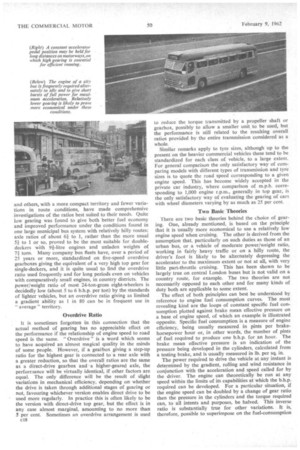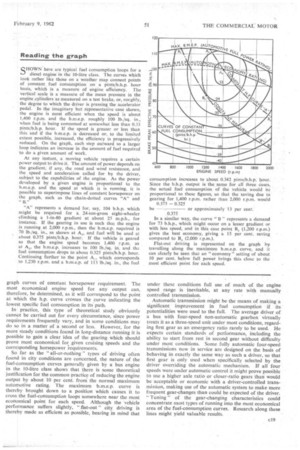ORSES FOR COURSES
Page 49

Page 50

Page 51

If you've noticed an error in this article please click here to report it so we can fix it.
THE idea of some of his buses or lorries being unnecessarily wasteful of fuel would horrify most operators, yet wastage due to unsuitably chosen gearing is by no means uncommon. To some extent it is inevitable, since the choice of ratio for any vehicle is a matter of compromise and, in addition, there are obvious economic limits to the number of alternatives a manufacturer can offer. Optimum fuel economy is not the only criterion by which the gearing of a vehicle is chosen, although it is probably not far from the truth to say that the most suitable choice in this respect will generally provide the best all-round performance for the circumstances in question.
In general, at any rate for running at more or less constant speed, the most economical ratio that can be used at any instant is likely to be that giving the minimum engine r.p.m. in relation to road speed. In other words, high gearing, as that expression is normally understood in automobile engineering, is usually conducive to economy. This does not necessarily mean that the vehicle with the highest-geared transmission is the most economical under all circumstances. Too high a top gear on a vehicle operating in traffic, with frequent stops and starts, or in a hilly district, simply causes the driver to use the lower ratios to a greater extent. The average ratio in use over a whole journey with an unduly high-geared vehicle might well prove to be lower than if top gear was low enough to allow it to be employed for longer periods.
Virtually all commercial vehicle manufacturers offer alternative rear-axle ratios, and in many cases options of gearboxes with additional ratios or two-speed rear axles, to enable the most satisfactory choice for the circumstances to be made. Some, but not all, offer an advisory service to help the operator in deciding what is best for his needs, taking into account the nature of his routes, the weight at which the vehicle will run and any other considerations.
It is interesting to recall that when Mercedes-Benz took part in motor racing a few years ago it was their normal practice to study each circuit individually and thus arrive at the precise axle ratio which would enable their cars to perform to the best possible advantage. Such a procedure is not practical for vehicles liable to be called upon to go "anywhere," but something similar might well prove worth considering for commercial vehicles which are confined to definite routes or areas. If a vehicle is to operate continuously on one particular type of service for, say, two years or more, the saving of fuel obtainable by fitting the most suitable axle ratio might well be found to more than justify the expense of changing, if the existing ratio is very unsatisfactory. This particularly applies to second-hand vehicles.
Different Types of Service
It is by no means uncommon for buses owned by large concerns to remain at one garage for a considerable part of their lives, and sometimes to be confined to a particular route for much of that time. Fleet standardization may mean that buses with identical specifications are sent to different parts of the system for operation on completely different types of service—one, perhaps, on local work in a hilly town, while another is to spend its days on flat country routes. The initial cost of having each geared to suit its type of duty is virtually nil and the extra expense of catering for the needs of individual areas is not likely to be large, especially since axles are normally maintained on a unit exchange basis in such fleets. Occasionally, due to some emergency, a vehicle with the wrong ratio may have to be used on a particular route, but this does not alter the fact that useful savings can be made.
Some operators already carry out systems of this sort c t 7 and others, with a more compact territory and fewer variations in route conditions, have made comprehensive investigations of the ratios best suited to their needs. Quite low gearing was found to give both better fuel economy and improved performance under the conditions found in one large municipal bus system with relatively hilly routes; axle ratios of about 61 to 1, rather than the more usual 51 to I or so, proved to be the most suitable for doubledeckers with 91-litre engines and unladen weights of 7i tons. Many company bus fleets have, over a period of 25 years or more, standardized on five-speed overdrive gearboxes giving the equivalent of a very high top gear for single-deckers, and it is quite usual to find the overdrive ratio used frequently and for long periods even on vehicles with comparatively small engines, in country districts. The power/weight ratio of most 24-ton-gross eight-wheelers is decidedly low (about 5 to 6 b.h.p. per ton) by the standards of lighter vehicles, but an overdrive ratio giving as limited a gradient ability as 1 in 80 can be in frequent use in " average " territory.
Overdrive Ratio
It is sometimes forgotten in this connection that the actual method of gearing has no appreciable effect on the performance if the relationship of engine speed to road speed is the same. " Overdrive " is a word which seems to have acquired an almost magical quality in the minds of some people. However, if a gearbox giving a step-up ratio for the highest gear is connected to• a rear axle with a greater reduction, so that the overall ratios are the same as a direct-drive gearbox and • a higher-geared axle, the performance will be virtually identical, if other factors are equal. The only difference will be the result of slight variations in mechanical efficiency, depending on whether the drive is taken through additional stages of gearing or not, favouring whichever version enables direct drive to be used more regularly. In practice this is often likely to be the version with direct-drive top gear, but the effect is in any case almost marginal, amounting to no more than 5 per cent. Sometimes an overdrive arrangement is used c18 to reduce the torque transmitted by a propeller shaft or gearbox, possibly to allow a smaller unit, to be used, but the performance is still related to the resulting overall ratios provided by the entire transmission considered as a whole.
Similar remarks apply to tyre sizes, although up to the present on the heavier commercial vehicles these tend to be standardized for each class of vehicle, to a large extent. For general comparison the only satisfactory way of comparing models with different types of transmission and tyre sizes is to quote the road speed corresponding to a given engine speed. This has become widely accepted in the private car industry, where comparison of m.p.h. corresponding to 1,000 engine r.p.m., generally in top gear, is the only satisfactory way of evaluating the gearing of cars with wheel diameters varying by as much as 25 per cent.
Two Basic Theories
There are two basic theories behind the choice of gearing. One, already mentioned, is based on the principle that it is usually more economical to use a relatively low engine speed when cruising. The other is derived from the assumption that, particularly on such duties as those of an urban bus, or a vehicle of moderate power/weight ratio, working in fairly heavy traffic or on a hilly route, the driver's foot is likely to be alternately depressing the accelerator to the maximum extent or not at all, with very little part-throttle cruising. This has been shown to be largely true on central London buses but is not valid on a country route, for example. The two theories are not necessarily opposed to each other and for many kinds of duty both are applicable to some extent.
The effect of both principles can best be understood by reference to engine fuel consumption curves. The most revealing kind are the loops of constant specific fuel consumption plotted against brake mean effective pressure on a base of engine speed, of which an example is illustrated opposite. Specific fuel consumption is a measure of engine efficiency, being usually measured in pints per brakehorsepower hour or, in other words, the number of pints of fuel required to produce one b.h.p. for an hour. The brake mean effective pressure is an indication of the pressure being developed in the cylinders, calculated from a testing brake, and is usually measured in lb. per sq. in.
The power required to drive the vehicle at any instant is determined by the gradient, rolling and wind resistance in conjunction with the acceleration and speed called for by the driver. The engine can theoretically be run at any speed within the limits of its capabilities at which the b.h.p. required can be developed. For a particular situation, if the engine speed can be doubled by a change of gear ratio then the pressure in the cylinders and the torque required can, to all intents and purposes, be halved. This inverse ratio is substantially true for other variations. It is, therefore, possible to superimpose on the fuel-consumption graph curves of constant horsepower requirement. The most economical engine speed for any output can, therefore, be determined, as it will correspond to the point at which the h.p. curve crosses the curve indicating the lowest specific fuel consumption in its path.
In practice, this type of theoretical study obviously cannot be carried out for every circumstance, since power requirements frequently vary, and in some conditions may do so in a matter of a second or less. However, for the more steady conditions found in long-distance running it is possible to gain a clear idea of the gearing which should prove most economical for given cruising speeds and the corresponding horsepower requirements.
So far as the "all-or-nothing" types of driving often found in city conditions are concerned, the nature of the fuel-consumption curves generally given by a bus engine in the 10-litre class shows that there is some theoretical justification for the common practice of reducing the engine output by about 10 per cent, from the normal maximum automotive rating. The maximum b.m.e.p. curve is thereby brought down to a position which causes it to cross the fuel-consumption loops somewhere near the most economical point for each speed. Although the vehicle performance suffers slightly, " flat-out " city driving is thereby made as efficient as possible, bearing in mind that
under these conditions full use of much of the engine speed range is inevitable, at any rate with manually controlled transmission.
Automatic transmission might be the means of making a significant improvement in fuel consumption if its potentialities were used to the full. The average driver of a bus with four-speed non-automatic gearbox virtually treats it as a three-speed unit under most conditions, regarding first gear as an emergency ratio rarely to be used. He expects certain standards of performance, including the ability to start from rest in second gear without difficulty under most conditions. Some fully automatic four-speed transmissions now in service are designed on the basis of behaving in exactly the same way as such a driver, so that first gear is only used when specifically selected by the driver overriding the automatic mechanism. If all four speeds were under automatic control it might prove possible to use a higher axle ratio or closer-ratio gears than would be acceptable or economic with a driver-controlled transmission, making use of the automatic system to make more frequent gear-changes than could be expected of the driver. "Tuning" of the gear-changing characteristics could concentrate most types of running into the most economical area of the fuel-consumption curves. Research along these lines might yield valuable results.
















































































































